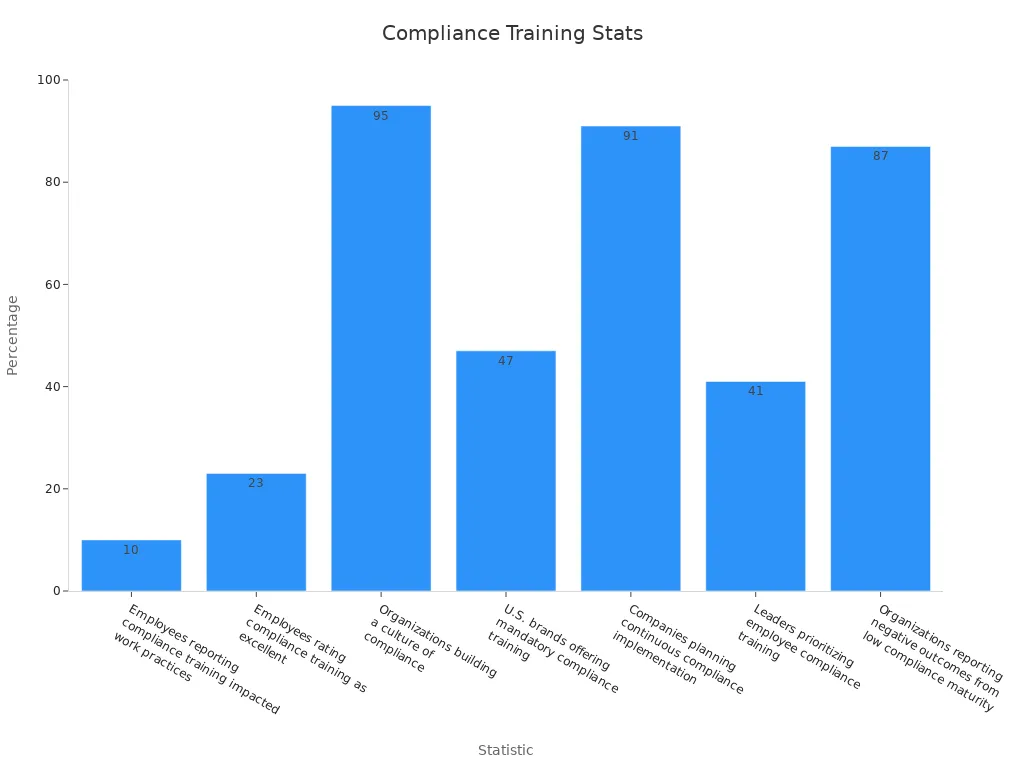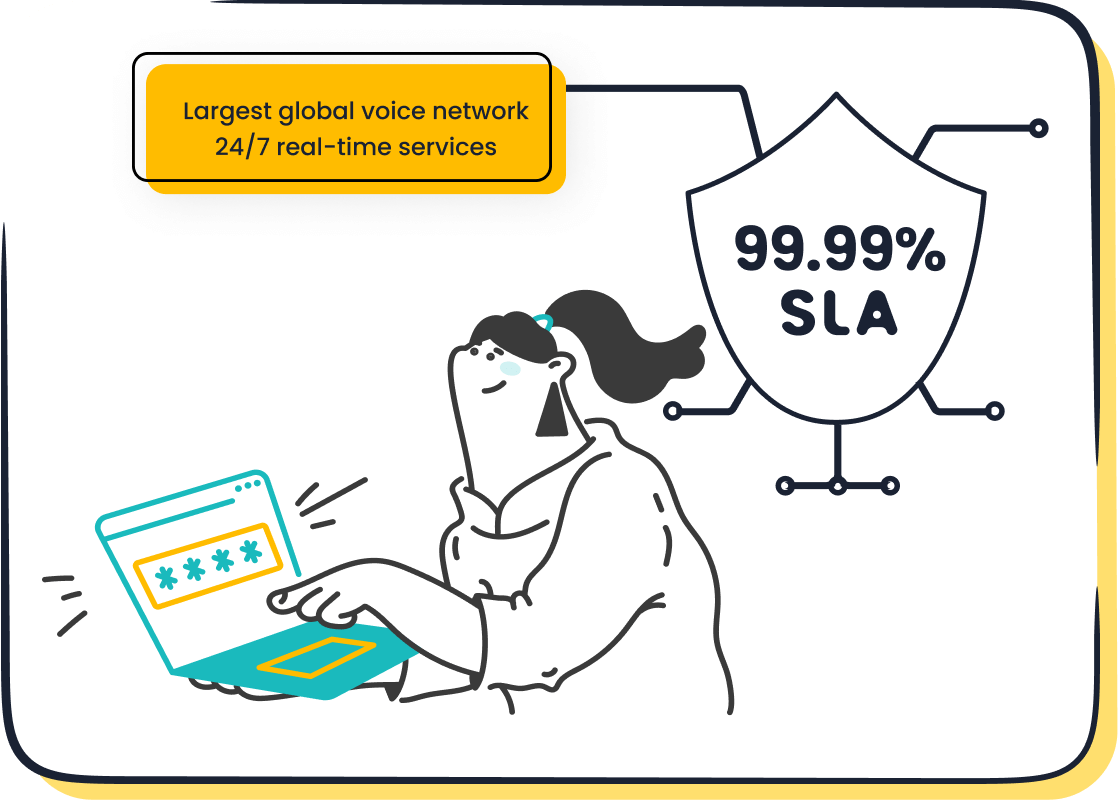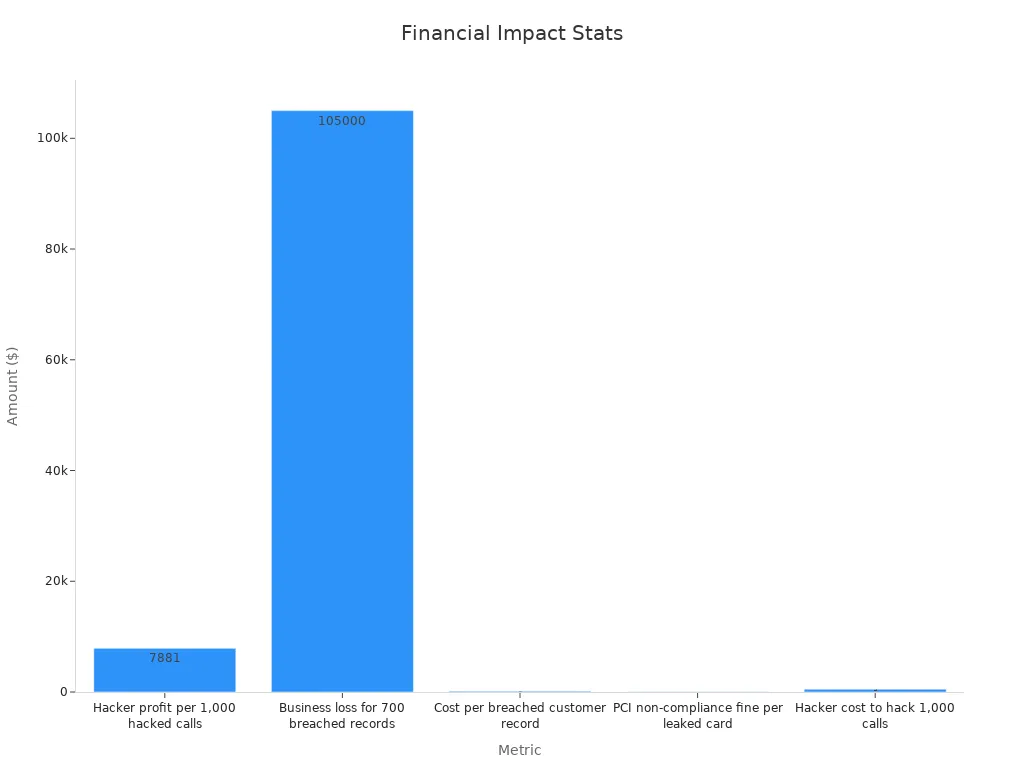How 2025 Call Center Regulations Impact Your Business

Business leaders now face unprecedented challenges as call center compliance becomes more complex with the arrival of 2025 call center regulations. Imagine a scenario where a single misstep in new rules leads to costly data breaches. The rapid growth of remote work and AI-driven systems, like Sobot AI, demands immediate action. Consider these trends:
| Metric Category | Statistic Description | Value |
|---|---|---|
| Contact Center Satisfaction | Consumers 2.6 times more likely to purchase if wait times are satisfactory | 2.6x increase |
| Agent Knowledge | Satisfaction with agent knowledge increased year-over-year | +2.6 percentage points YoY |
| AI Concerns | Consumer comfort using AI declined year-over-year | -11% YoY |
Call center compliance safeguards trust and keeps operations efficient. Sobot empowers companies to meet new rules, maintain customer loyalty, and avoid the risks that come with non-compliance.
2025 Call Center Regulations

Key Changes
The 2025 call center regulations introduce a broad set of changes that affect every aspect of call center compliance. Lawmakers have passed new rules at both the state and federal levels. These changes include stricter consent rules, enhanced caller ID requirements, and expanded definitions for robocalls and robotexts.
Many states, such as Illinois, California, Tennessee, New York, and Connecticut, have passed bills that strengthen consent, caller ID, and Do Not Contact rules. The federal government has also updated the TCPA consent rule changes, with the FCC leading enforcement efforts.
The FCC now requires call centers to use caller ID authentication technology, such as STIR/SHAKEN, to prevent fraud. The agency has also expanded the scope of compliance monitoring, using AI and cloud-based tools to detect violations in real time. These regulatory changes mean that call centers must update their systems and processes to meet new compliance standards.
A table below shows how recent laws have increased penalties and shortened cure periods for violations:
| Regulatory Law | Fine per Violation | Cure Period | Effective Date | Key Compliance Requirement |
|---|---|---|---|---|
| Iowa Privacy Law | $7,500 | 90 days | Jan 1, 2025 | Opt-out consent for sensitive data |
| Delaware Data Protection Act | $7,500 | 60 days | Jan 1, 2025 | Opt-in consent; universal opt-out by 2026 |
| Indiana Consumer Data Protection Act | $7,500 | 30 days | Jan 1, 2026 | Opt-in consent; data protection impact assessments |
| Rhode Island Data Transparency Act | $100-$500 | None | Jan 1, 2026 | Detailed privacy notices; opt-in consent |
Call center compliance now requires faster responses to opt-out requests and more robust documentation. The FCC expects call centers to honor opt-out requests within 10 business days, starting April 11, 2025. These key changes demand that call centers, including those using Sobot’s omnichannel solutions, adapt quickly to avoid penalties and maintain customer trust.
Consent and Data Rules
Consent and data handling rules have become much stricter under the 2025 call center regulations. The FCC’s TCPA consent rule changes focus on one-to-one consent, meaning each consumer must give prior express written consent for a specific seller to contact them. The FCC’s new rules also clarify that consumers can revoke consent in any reasonable way, and call centers must process opt-out requests within 10 business days.
The Eleventh Circuit Court of Appeals vacated the FCC’s one-to-one consent rule in 2025, but the agency still enforces prior express written consent as a clear agreement between the consumer and the seller. The FCC’s revocation rule, effective April 11, 2025, gives consumers more control over their data and communications.
States have also passed new data privacy laws. For example, New Jersey requires affirmative consent from minors for targeted ads, and Maryland bans the sale of sensitive data. These changes mean that call center compliance now involves tracking consent for each customer, managing opt-out requests, and ensuring data privacy at every step.

Sobot’s Voice/Call Center platform helps businesses manage these requirements by providing secure, encrypted data transfer and automated tracking of consent and opt-out requests. The unified workspace allows agents to see customer consent status in real time, making compliance easier and more reliable.
New Definitions
The 2025 call center regulations introduce new definitions that expand the scope of compliance. The FCC now includes robotexts and automated messages in its definition of telemarketing communications. The agency also broadens the meaning of prior express written consent, requiring clear, unmistakable agreements for each seller.
The FCC’s key TCPA updates now cover both robocalls and robotexts, reflecting how consumers use mobile devices today.
States have also updated their definitions. For example, Minnesota now requires companies to appoint a Chief Privacy Officer, and Maryland restricts the processing of minors’ data for targeted advertising. These new definitions mean that call center compliance covers more types of communication and more customer data than ever before.
Call centers must update their policies and train staff to understand these new rules. Sobot’s omnichannel solution supports compliance by integrating all communication channels—voice, chat, email, and SMS—into a single platform. This integration helps businesses stay compliant with the latest regulatory requirements and respond quickly to new rules as they emerge.
Business Impacts
Operational Changes
The 2025 call center regulations bring significant changes to daily operations. Call center compliance now requires teams to update scripts, monitor calls, and document every opt-out request. Managers must track consent for each customer and respond to opt-out requests within 10 business days. These changes increase the need for real-time monitoring and fast adaptation. Sobot’s Voice/Call Center platform helps businesses automate call tracking, manage opt-out requests, and maintain call center compliance with a unified workspace. Companies like Weee! have improved agent efficiency by 20% and reduced resolution time by 50% after adopting Sobot’s flexible IVR and integrated workbench. These results show how technology supports compliance and operational excellence.
Customer Experience
Customer experience now depends on strict call center compliance. Customers expect their opt-out requests to be honored quickly and their data to remain secure. The 2025 regulations require call centers to process opt-out requests faster and provide clear consent options. Sobot’s omnichannel solution allows agents to view customer consent status in real time and respond to opt-out requests across all channels. Weee! achieved a 96% customer satisfaction score by using Sobot’s multilingual support and time zone features. These improvements build trust and loyalty, which are essential for long-term success.
Technology Needs
Call center compliance in 2025 relies on advanced technology. Most call centers now use AI, cloud-based solutions, and chatbots to meet new compliance standards. Key trends include:
- 80% of call centers use AI-based technologies to improve service.
- 66% use cloud-based solutions for flexibility and scalability.
- 65% have integrated chatbots for basic customer service.
- Over 90% of customers expect seamless omnichannel communication.
Sobot’s Voice/Call Center and omnichannel solutions help businesses meet these needs. The platform offers AI-powered voicebots, encrypted data transfer, and real-time analytics. These features support call center compliance, reduce manual work, and ensure every opt-out request is handled properly. As regulations change, technology like Sobot’s keeps businesses ready for the future.
Call Center Compliance Steps
Documentation
Effective call center compliance begins with meticulous documentation. Every call center must maintain structured records that include version control, timestamps, and categorized files. These practices allow teams to retrieve information quickly and demonstrate compliance during audits. Accurate records with clear audit trails and adherence to retention schedules support regulatory compliance and help avoid penalties.
- Structured documentation systems with digital tools enable real-time monitoring and transparency.
- Compliance document managers organize records, prepare for audits, and address auditor inquiries.
- Regular employee training on documentation procedures ensures accuracy and accountability.
- Maintaining both paper and electronic records requires clear procedures and integration for traceability.
- Good documentation practices support compliance, data integrity, and effective decision-making.
Sobot’s Voice/Call Center platform offers automated tracking and secure storage of opt-out requests, consent forms, and call logs. This unified workspace helps agents and managers maintain compliance with evolving regulations and opt-out policies.
Training
Comprehensive training is essential for call center compliance. Employees must understand new regulations, opt-out procedures, and documentation protocols. Training programs should cover the importance of compliance, how to process opt-out requests, and the use of compliance monitoring tools.
| Statistic Description | Value | Implication |
|---|---|---|
| Employees reporting compliance training impacted work practices | 10% | Indicates training effectiveness despite low perception |
| Organizations building a culture of compliance | 95% | Demonstrates widespread commitment to compliance (Accenture) |
| U.S. brands offering mandatory compliance training | 47% | Reflects adoption of compliance training methods (Statista) |
| Companies planning continuous compliance implementation | 91% | Highlights future focus on ongoing training (Drata) |
| Average annual cost from non-compliance issues | $14.82 million | Demonstrates financial consequences of poor training |

Sobot provides ongoing training resources and support for agents and administrators. The platform’s intuitive interface and regular updates help teams stay current with compliance requirements and process opt-out requests efficiently.
Monitoring
Continuous compliance monitoring ensures that call centers meet regulatory standards and adapt to changes. Monitoring involves tracking key risk indicators (KRIs) and key performance indicators (KPIs) such as compliance status, control effectiveness, incident response time, and training completion rates.
- Compliance status by framework
- Control effectiveness by process
- Incident reporting and response time
- Training completion rates
- Audit findings and remediation time
- Policy adherence
- Issues management effectiveness
- Recurrence and trend analysis of incidents
Sobot’s real-time analytics and reporting tools enable managers to monitor compliance across all channels. Automated alerts notify teams of potential issues, while dashboards provide insights into opt-out request handling and policy adherence. Regular audits and feedback loops help call centers identify gaps, improve compliance monitoring, and maintain operational integrity.
Risks of Non-Compliance

Legal Penalties
Call center compliance failures can lead to severe legal penalties. The fcc enforces strict rules to protect consumers from unwanted calls and data misuse. Regulatory frameworks such as TCPA, HIPAA, PCI DSS, and DNC Registry set clear standards for call center compliance. When a call center ignores these rules, the consequences of non-compliance can be devastating.
- Monetary fines for TCPA violations range from $500 to $1,500 per occurrence.
- Class-action lawsuits may result in settlements reaching millions or even billions of dollars.
- Civil penalties can multiply quickly if violations are willful or repeated.
- Legal actions often require call centers to implement costly remedial compliance programs.
- Regulatory scrutiny can expand to investigations by agencies like the FTC or state attorneys general.
Proactive call center compliance, including regular audits and consent management, helps reduce these risks.
Reputation
The consequences of non-compliance extend beyond legal penalties. A single compliance failure can damage a call center’s reputation and erode customer trust. Studies show that operational risk events, including compliance failures, account for over 52% of reputational risk disclosures. High-profile scandals, such as the UBS rogue trader incident, led to billions in market value loss due to reputational harm.
- Data breaches and privacy leaks often result in negative media coverage.
- Loss of customer trust can lead to contract terminations and business loss.
- Regression analyses confirm that fraud, corruption, and security risks drive reputational damage.
Sobot’s call center compliance solutions help businesses maintain a strong reputation by ensuring secure, transparent, and compliant operations.
Financial Impact
Non-compliance can cripple a call center’s finances. Fines, lawsuits, and operational disruptions drain resources and reduce profits. In 2020, U.S. banks paid $11.39 billion in fines due to non-compliance, with major institutions accounting for over $7.5 billion. Call centers face similar risks, including unauthorized charges from fraud and high costs for system recovery.
| Metric | Value |
|---|---|
| Hacker profit per 1,000 hacked calls | $7,881 |
| Business loss for 700 breached records | $105,000 |
| Cost per breached customer record | $150 (IBM report) |
| PCI non-compliance fine per leaked card | $25 |
| Hacker cost to hack 1,000 calls | $519 |

- Increased operational costs arise from corrective measures and higher insurance premiums.
- Loss of financial partners and customers adds to the financial strain.
- Operational disruptions from audits and legal proceedings divert resources from core business.
Sobot’s call center compliance tools, such as real-time monitoring and secure data handling, help organizations avoid these financial pitfalls and ensure ongoing compliance.
Adapting to New Rules
Sobot Solutions
Sobot’s omnichannel and Voice/Call Center solutions help businesses achieve call center compliance with the latest 2025 regulations. The platform integrates AI-powered tools, secure data handling, and real-time analytics to support compliance across every customer interaction. Sobot’s system reduces agent workload by 60%, increases conversion rates by 15%, and improves Net Promoter Scores by 35%. Most issues resolve in less than one minute, delivering a 234% return on investment. These results show that Sobot’s technology not only meets compliance standards but also drives operational excellence.
| Performance Metric | Improvement/Value |
|---|---|
| Agent Workload Reduction | 60% reduction |
| Conversion Rate Increase | 15% increase |
| Net Promoter Score (NPS) | 35% improvement |
| Resolution Time | Less than 1 minute |
| Return on Investment (ROI) | 234% ROI |
Sobot’s platform supports over 300 statistical reports and thousands of indicators, making it easy for call center managers to monitor compliance and adapt to new rules. The unified workspace ensures agents can track consent, manage opt-out requests, and maintain call center compliance efficiently.
Best Practices
Industry best practices for call center compliance focus on structured training, digital transformation, and continuous improvement. Organizations with structured compliance training see 65% fewer regulatory violations. Digital compliance tools improve efficiency by 41% and reduce costs by 29%. External compliance experts help reduce regulatory findings by 32%. Companies use governance, risk, and compliance platforms to centralize compliance management and automate real-time monitoring.
- Soft law mechanisms, such as codes of conduct, allow quick adaptation to new compliance trends in 2025.
- Regulatory sandboxes help test new technologies in a controlled environment.
- Continuous improvement frameworks reduce repeat compliance findings by 58%.
Sobot’s solutions align with these best practices by offering automated compliance monitoring, AI-driven analytics, and regular training resources. These features help call centers stay ahead of compliance trends in 2025 and maintain high standards.
Ongoing Updates
Compliance trends in 2025 show rapid changes in technology and regulations. Real-time analytics and reporting reduce reporting preparation time by up to 85% and improve accuracy by over 90% (KPMG, 2023). Automation and robotics cut manual tasks by up to 80% and decrease processing time by 60%. Mobile compliance apps improve timely task completion by 40% and reduce documentation errors by 55%. Data security advancements lower regulatory data breaches by 65%.
| Trend Category | Key Technologies / Features | Impact Metrics |
|---|---|---|
| Real-time Analytics & Reporting | Automated compliance monitoring | 85% less prep time, 90%+ accuracy |
| Automation & Robotics | RPA, cognitive automation | 70-80% fewer manual tasks, 50-60% faster processing |
| Mobile Applications | Compliance verification apps | 40% faster task completion, 55% fewer errors |
| Data Security Advancements | AI anomaly detection, encryption | 65% fewer data breaches |
Sobot’s platform incorporates these technologies, ensuring call center compliance remains strong as regulations evolve. Regular updates and proactive monitoring help businesses adapt to new compliance trends in 2025 and maintain operational integrity.
- The 2025 call center regulations demand that every call center update processes, train staff, and use advanced technology.
- Regular call center audits, continuous monitoring, and employee training help each call center avoid costly mistakes.
- Cross-functional teamwork and technology, like Sobot’s call center solutions, streamline compliance and boost accuracy.
- Predictive analytics and automated alerts let a call center spot risks early and adapt fast.
- A call center that invests in proactive compliance, as shown by a 40% drop in incidents at a major bank, gains a clear advantage.
Every call center should stay informed, use expert advice, and choose solutions like Sobot to ensure ongoing compliance and business growth.
FAQ
What are the most important 2025 call center regulations for businesses?
The 2025 call center regulations focus on consent, data privacy, and faster opt-out processing. Every call center must update scripts, monitor calls, and document customer requests. Sobot’s platform helps businesses meet these requirements with real-time analytics and secure data handling.
How can a call center ensure compliance with new consent rules?
A call center must track consent for every customer and process opt-out requests within 10 business days. Sobot’s Voice/Call Center solution automates consent tracking and provides a unified workspace for agents. This helps every call center stay compliant and avoid penalties.
Why does call center compliance matter for customer trust?
Customers expect a call center to protect their data and honor opt-out requests quickly. A compliant call center builds trust and loyalty. For example, Weee! improved its customer satisfaction score to 96% after using Sobot’s multilingual support and flexible IVR system.
What technology does a call center need for 2025 compliance?
A modern call center needs AI-powered tools, cloud-based systems, and real-time monitoring. Sobot’s omnichannel and Voice/Call Center solutions offer these features. Over 80% of call centers now use AI to improve compliance and efficiency (source).
How does Sobot help a call center adapt to regulatory changes?
Sobot provides a call center with automated compliance monitoring, secure data transfer, and regular updates. The platform supports over 300 statistical reports, making it easy for a call center to track compliance and adapt to new rules as regulations evolve.
See Also
Discover The Leading Cloud Contact Centers For 2025
Comprehensive Review Of Best Contact Center Solutions 2024
Best Cloud Contact Center Services Evaluated For 2024
